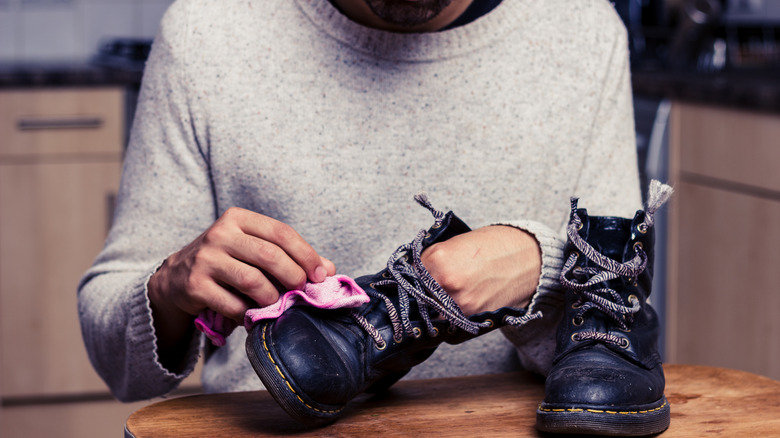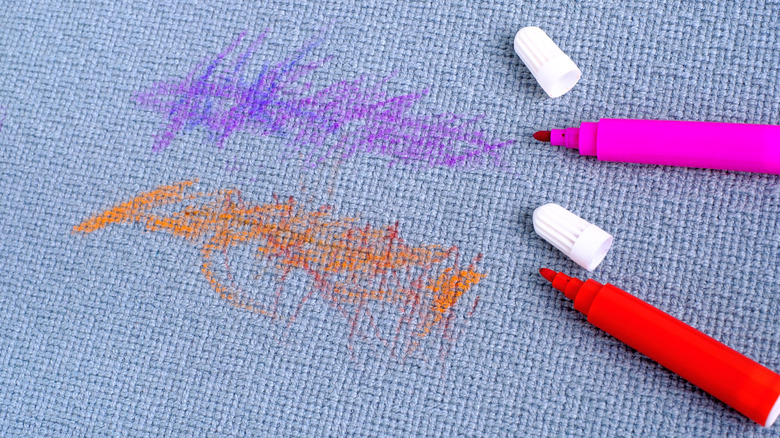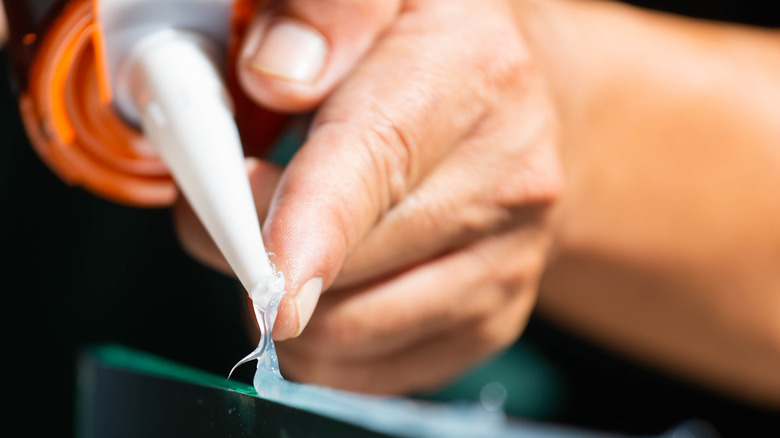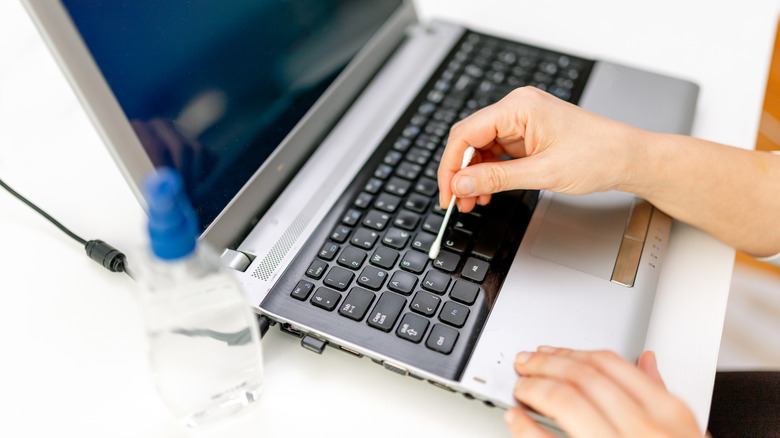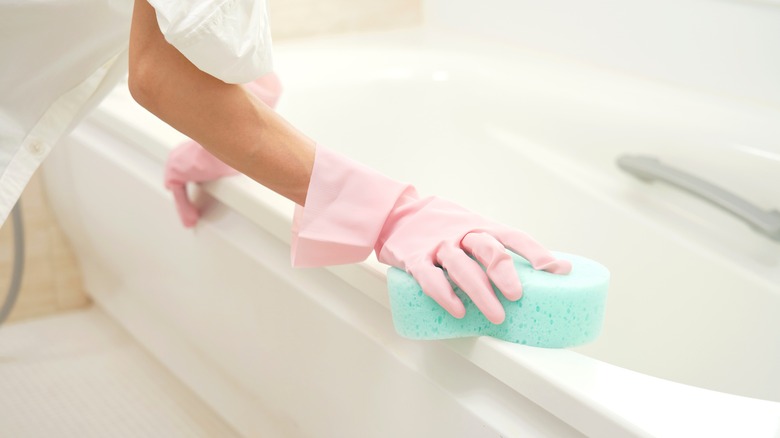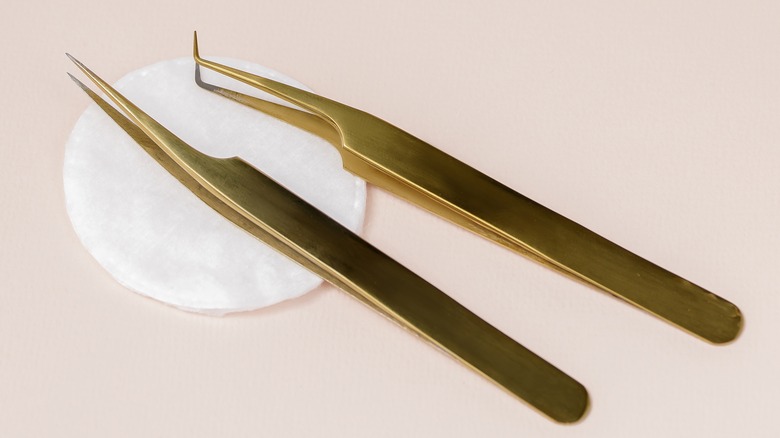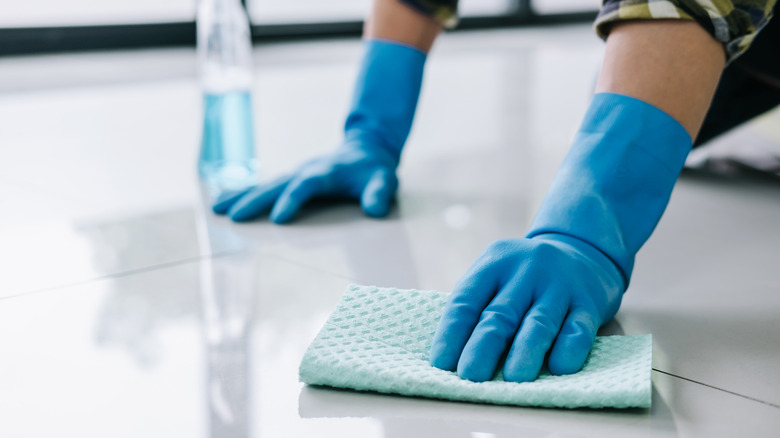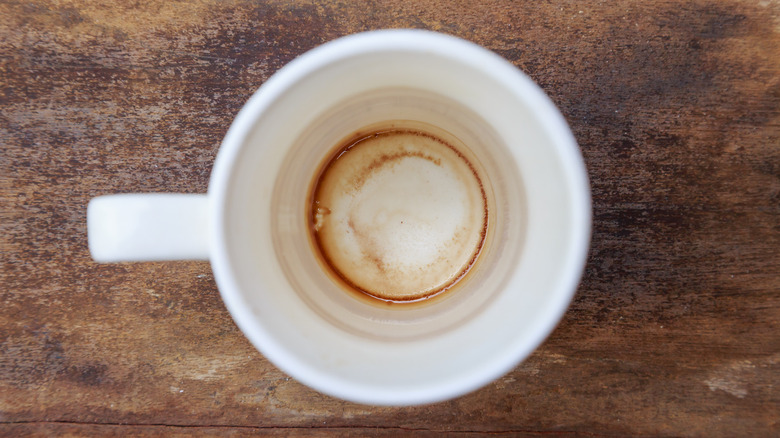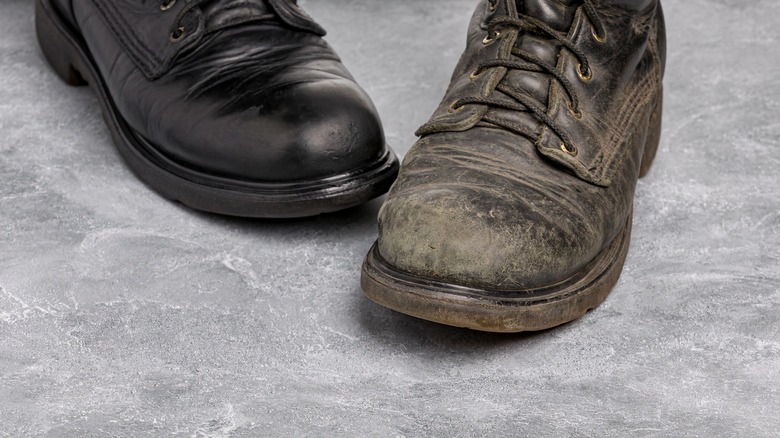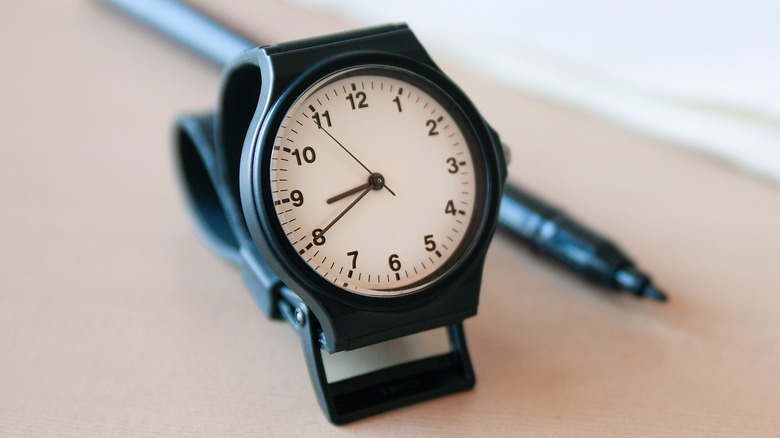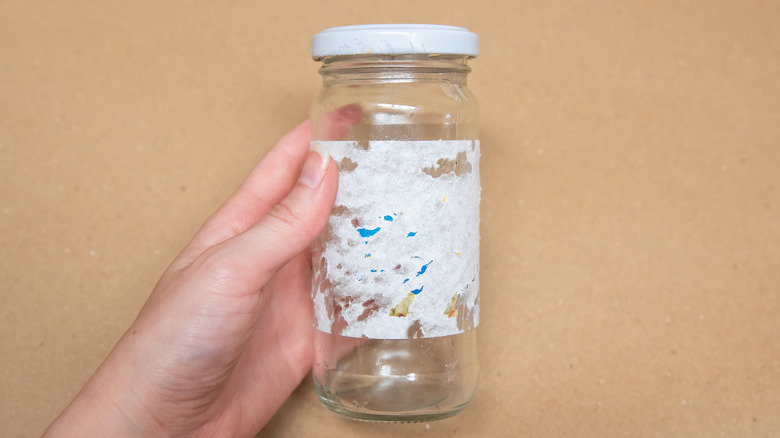Nail Polish Remover Hacks To Try Around The House
Nail polish remover is something that most everyone likely has in their bathroom cabinet, but did you know that this household staple has many uses beyond removing your manicure? From your kitchen to your closet, nail polish remover can help you tackle some tough tasks all around your home with ease. This is because it is made from a substance called acetone. Acetone is classified as a volatile liquid solvent – with volatile meaning quick to evaporate at room temperature and solvent meaning a substance capable of dissolving other substances. Together, these attributes turn nail polish remover into a cleaning powerhouse capable of tackling tough messes while leaving no residue that ordinary soap might not be strong enough to handle.
In the case of nail polish, a few quick swipes of remover will break down the hard polish so that it can be easily wiped away. Because the acetone evaporates very quickly, it is ideal for use on some delicate materials, like nails, since it won't soak into the surface. Sold for under $3 at most drugstores, it is a much cheaper alternative to many specialized cleaning products that would have the same effect for a higher price. So grab a bottle and take a look at your to-do list, because here are 10 nail polish remover hacks to try around the house.
Remove permanent marker
Even if you're careful, sometimes you accidentally drop your marker or your kids decide that your house is their canvas. But despite the name, there is a way to get permanent marker out of most materials. Nail polish remover will work to break down the ink and lift it as it evaporates, making it easier to wipe away. This hack works best if the ink is on fabric, glass, or your skin. You will want to avoid using it on anything made from wood since the acetone will eat away at any varnish on the piece, making it look patchy and uneven.
Before using nail polish remover on any surface, you should do a small spot test in an inconspicuous area. While the acetone will remove the stain, it might also remove other things like paint or finish if you're not careful. Use a small amount of remover on a cotton ball or swab, depending on the size of the mark you want to remove. Don't oversaturate the cotton; otherwise there will be unwanted drips. Gently blot the area to start lifting the stain, then scrub the marker away. If there is any leftover residue, wipe the area with a damp paper towel and your item should be back to normal.
Dissolve super glue on hands
Super glue's ultra strong bond makes it perfect for household repairs, but if you get it on your skin, it can quickly turn into a race against the clock to figure out how to get it off before it dries. Even if it does dry, super glue is no match for nail polish remover since the acetone will overpower and dissolve its bonds. The concern here is about potential irritation to the skin. While polish remover is designed to not be harmful since it will come in contact with your fingers and cuticles, using it repeatedly on a larger area of skin might cause some irritation and dryness. So proceed with caution, and if you feel any burning sensation, stop using it immediately and thoroughly rinse your skin.
Though it might be difficult if you stuck your fingers together, take a cotton ball and soak it in polish remover. Hold it against your skin as close as you can to the glued area, and let it fully saturate. You should feel the glue bond start to slowly release. Don't pull on your skin or try to force the glued areas apart, as this could cause damage to your skin. Just repeat the process with a freshly soaked cotton ball until the bonds loosen and any remaining glue can be wiped away. Wash the affected area with soap and water to remove any lingering glue or polish remover.
Clean your keyboard
Our computer keyboard is one of the things we use most throughout the day, transferring all of the grime and oil from our fingers to the keys, which are tiny and have so many crevices they can feel impossible to clean. While you don't want to get nail polish remover on your computer screen, naturally quick-lifting acetone is the perfect way to clean the keyboard. It won't leave a film that could potentially interfere with the keys' functionality like other cleaners.
For this hack, you will want to use a cotton swab since the small tip will be able to get into that hard-to-clean space in between the keys. Moisten the cotton swab with nail polish remover, but don't soak it so much that it is dripping. You don't want any excess to leak beneath the keys. Gently wipe the keyboard, getting between the rows and on the surface of the keys. This should dissolve any dirt or oil stains, leaving your tech looking as good as new.
Get rid of a ring around the bathtub
With prolonged use, an unsightly ring can form around your bathtub. These rings can look yellow or brown, and while it isn't inherently unsanitary, it can make your bathroom look dirty even if you've just cleaned it. This ring is the result of soap scum and the oils in various products, and bath bombs in particular can cause them due to their strong pigments. Luckily, the acetone in nail polish remover is great at powering through these types of stains to get your bathtub sparkling without a ton of elbow grease.
First, open a window to allow proper ventilation. Grab a towel or sponge and pour some nail polish remover on it. Start scrubbing the stain, and soon you should see it lift. After you are done cleaning, rinse the tub. You should always be cautious whenever cleaning to not mix chemicals. Bleaching a bathtub is common practice to eliminate germs and keep it shiny, but this is an absolute no-no if you have just cleaned it with acetone. Together, the two chemicals will form a toxic chloroform gas, so it is essential to stick to one cleaning product at a time when trying to battle a mess.
Sanitize tweezers and nail clippers
For metal grooming items like tweezers or nail clippers, you might not think that they need to be sanitized. However, it's still essential to clean these items to get rid of any germs and bacteria present. This is especially true if multiple people are using the same item. While nail polish remover isn't a medical-grade sanitizer, the acetone will act as a capable disinfectant, per a 1977 paper in the Annals of Ophthalmology journal.
Pour some nail polish remover into a cup or shallow bowl and insert any instrument you wish to sanitize. Leave them to soak for 5 minutes while the acetone works its magic. Once the time is up, remove your items and wash them with soap and warm water. This will remove any leftover polish remover as well as eliminate the strong smell of acetone. Clean and sanitize your grooming instruments regularly to prevent the spread of any bacteria that could cause issues like acne.
Erase floor scuffs
Shoes with black soles can often leave floors looking scratched and dirty, even if the marks are the result of a simple scuff. They can also be the result of furniture or ladders — basically anything with a black rubber bottom. Scuffs are usually oil-based stains, which means they probably won't budge even after being mopped with soap and water. Even store-bought floor cleaners might be formulated to tackle dirt-based grime but not do much to get rid of rubbery, oil-based scuffs. This is where nail polish remover is helpful. The acetone will power through that rubber residue to dissolve it, making it easier to be wiped off the floor.
This works great for certain types of flooring, like tile, vinyl, and laminate. However, you should not use this method if you have real wood floors since you will likely remove the wood stain along with any scuff, causing a potentially bigger problem. Depending on the size of the mark you are trying to remove, use a rag or cotton ball dipped in remover. Gently scrub the stain, being careful not to use large swipes that will spread the scuff mark around. Once the stain is lifted, go ahead and mop as normal. For the future, take preventative steps when moving furniture to prevent these scuffs from forming.
Remove tea stains from china
There is a vicious cycle for any tea lover of brewing a fresh cup, then immediately forgetting about it. As the tea sits in your cup, eventually it will seep into the china, leaving a stain that's difficult for soap and water to completely remove. If this has happened to you, look no further than your bottle of nail polish remover. While you might be hesitant to use something so powerful on a delicate material like china, as long as you are gentle with the scrubbing and wash the cup immediately after the stain is removed, you should be able to revitalize your tea set with no damage to the cup.
You'll want to use a cotton ball or a rag that is soft and not at all abrasive. The acetone will be doing all the cleaning work here, and you don't want to cause further damage by scratching the china. Moisten the cotton with some nail polish remover and gently scrub the tea stain in small, circular motions. Continue this all around the cup until the stain has lifted. Wash the cup thoroughly with soap and water so that you don't ingest any toxic chemicals once the next tea time rolls around.
Shine leather shoes
A good pair of leather shoes can last you a lifetime, if given the proper upkeep. Leather cleaners are effective, but expensive, and if you are short on time but need to give your shoes a boost before heading out the door, grab that bottle of nail polish remover. It will break down stains and scuffs, but since acetone evaporates quickly, it won't absorb into the leather like other household cleaners might.
Grab your shoes and a soft cloth. Dampen the cloth with a bit of nail polish remover and slowly start buffing away the stains. Make sure not to saturate the material, since this increases the likelihood that some of the acetone will be absorbed into the leather, which will harm the shoe. This hack also works for leather furniture and is especially helpful for pieces in high-traffic areas. After you've cleaned up your shoes, consider taking the extra step to keep your leather soft and supple by conditioning it with coconut oil, another household staple.
Revive a plastic watch face
Using acetone on plastic has to be done with extreme care since the acetone will cause plastic to soften, deform, and eventually break down completely. However, if you work carefully using a controlled amount, this same principle can be used to even out scratches on a small plastic item, like the face of a watch. If you have bumps, cuts, or dings, using a small amount of acetone will break it down just enough to smooth it out without causing any damage.
The key to this hack is to gently swipe the polish remover over any cuts or scrapes and never to rub. Use a cotton swab and wet it with a small amount of polish remover. Then gently brush it over any area you want to revive. Work slowly, and don't add too much polish remover at once or get impatient and start scrubbing. Eventually your watch face or other small plastic item should be revived. Just give it one final wipe with fresh water to remove any lingering acetone to ensure it doesn't ruin the plastic.
Remove stickers
It is completely frustrating when you buy a new vase or glass that you know will look elegant in your home, only to try and peel off the price tag sticker and see it tearing into tiny pieces and leaving an ugly residue behind. Not only will this half-torn sticker distract from the beauty of the item, if not removed, the sticker glue will attract dirt and dust. Finally, this problem has a solution in the form of nail polish remover taking those stickers off glass décor items. Similar to how acetone is effective in removing superglue, the polish remover will break down the bonds in the sticker glue. Then, it should be much easier to wipe off.
Grab your item with the sticker and generously soak a cloth (or paper towel or cotton ball) with nail polish remover. Leave the cloth over the sticker for about 20 minutes. This will give the acetone time to fully destroy the glue bonds. Because you leave the acetone on for so long, it is important to only use this hack on surfaces that acetone won't harm, like glass. After the 20 minutes is up, scrub away the residue. Once it is fully removed, wash the item as normal and your new glass item will be sticker-free!
